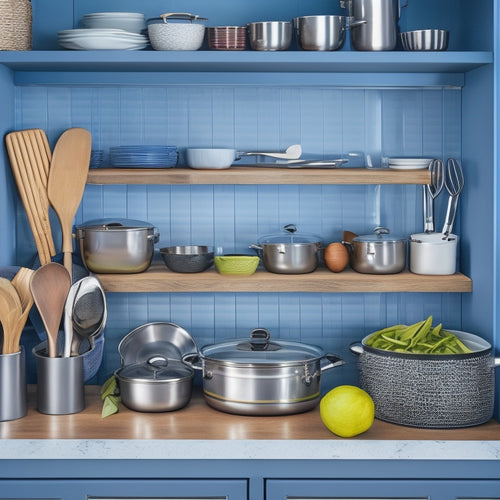
Efficient Receipt Management: Creative Storage Solutions Unleashed
Share
You're just a step away from revealing the secret to efficient receipt management. By implementing a solid receipt organization system, you'll maximize tax deductions and credits, ensure compliance certainty, and reduce audit risk. physical storage methods like filing cabinets and boxes work, but digital solutions like cloud storage and mobile apps take it to the next level. Get creative with stylish storage ideas, from repurposed wooden boxes to DIY organizers, to turn receipt storage into an art form. As you explore these solutions, you'll discover how to save time, reduce stress, and stay on top of your finances in ways you never thought possible.
Key Takeaways
• Combine physical and digital storage methods to create a hybrid receipt organization system for maximum efficiency.
• Utilize creative storage containers like wooden boxes or mason jars to add personality to your workspace while staying organized.
• Implement a categorization and tagging system for easy searching and filtering of digital receipts.
• Consider using cloud-based storage solutions for automatic backups and secure access to receipts from anywhere.
• Design a customized DIY organizer using binders, folders, and dividers to fit your specific receipt management needs.
Importance of Receipt Organization
When it comes to managing your finances, having a solid receipt organization system in place is crucial. It provides easy access to tax records and documentation for returns, allowing you to take advantage of all eligible deductions and credits.
By keeping your receipts organized, you'll enjoy numerous benefits, including maximizing tax deductions and credits. Proper record keeping also ensures compliance certainty, giving you peace of mind and reducing the risk of audits.
Additionally, organized receipts make it easier to track expenses, manage warranties, and facilitate returns. By implementing an effective receipt organization system, you'll be able to make informed financial decisions, optimize your expenses, and achieve greater financial control.
Storage Methods for Receipts
To efficiently store your receipts, you can utilize a combination of digital tools and physical filing systems, ensuring easy access to your financial records while keeping clutter at bay. This hybrid approach allows you to maintain a clean and organized space while preserving your receipts for future reference.
Here are some storage methods to contemplate:
-
Use storage boxes, file folders, and cabinets to keep your physical receipts organized and easily accessible.
-
Implement filing techniques such as categorizing receipts by date, vendor, or expense type to facilitate quick retrieval.
-
Ponder using mini stow file cabinets with casters for compact spaces, ensuring receipt preservation and easy access.
Digital Storage Solutions
By embracing digital storage solutions, you can trade cluttered physical spaces for a streamlined and efficient receipt management system that's always at your fingertips.
With cloud storage benefits, you can access your receipts from anywhere, at any time, and enjoy automatic backups to prevent data loss.
Mobile app advantages, such as Shoeboxed, allow you to scan and upload receipts on-the-go, making it easy to stay organized.
Digital storage solutions also enable you to categorize and tag receipts for easy searching and filtering. This means you can quickly find specific receipts, track expenses, and prepare for tax season with confidence.
Benefits of Going Digital
You'll reap numerous rewards by switching to digital receipt storage, including a significant reduction in paper clutter and increased security. This digital shift brings numerous benefits, making it an attractive option for efficient receipt management.
-
With digital organization, you can easily categorize and access your receipts, streamlining expense tracking and tax preparation.
-
Going paperless reduces your environmental footprint, contributing to a more sustainable future.
-
Digital storage solutions like Shoeboxed offer secure and efficient receipt management, saving you time and increasing productivity.
Creative Storage Ideas
Transform your receipt storage with creative, cost-effective solutions that combine functionality and style, such as repurposed wooden boxes or mason jars, to keep your receipts organized and easily accessible.
You can create your own DIY organizers using binders, folders, dividers, and labels. Get creative with unique containers that not only store your receipts but also add a touch of personality to your workspace.
Consider using durable materials and portable designs for convenience. By thinking outside the box, you can find a storage solution that fits your style and budget.
With a little creativity, you can turn receipt storage into an art form that also helps you stay organized and on top of your finances.
Frequently Asked Questions
How Do I Ensure My Digital Receipts Are Accepted by the Irs?
You guarantee your digital receipts are accepted by the IRS by following their requirements, such as retaining receipts in their original form, meeting acceptance criteria, and using a reputable digital storage service like Shoeboxed.
Can I Store Receipts for Personal Expenses Separately From Business Expenses?
You carefully categorize personal and business expenses by creating separate digital folders or physical files, allowing you to precisely organize receipts and effortlessly distinguish between personal and professional expenditures.
Are There Any Specific Receipt Storage Requirements for Freelancers or Self-Employed?
As a freelancer or self-employed individual, you'll want to separate personal and business expenses, organizing receipts for accurate tax deductions, ensuring you claim all eligible business expenses and deductions to minimize your tax liability.
How Long Should I Keep Receipts for Warranty and Return Purposes?
You should keep receipts for warranty and return purposes for the duration of the warranty period, typically ranging from 1-5 years, and up to 7 years for tax-related purposes, ensuring you're prepared for any warranty claim timelines.
Can I Use a Single Receipt Storage System for Multiple Businesses or Locations?
You're wondering if you can use a single receipt storage system for multiple businesses or locations? Consider Sarah, who runs three cafes and uses Shoeboxed to manage receipts, sharing storage across locations with ease and organized receipt organization.
Related Posts
-

Maximize Your Garage Space: A Comprehensive Guide
Decluttering and organizing your garage can seem like a daunting task, but it's a worthwhile investment that will...
-

Why Opt for Cabinet Drawer Organizers?
By opting for cabinet drawer organizers, you'll reveal more storage space, reduce kitchen clutter stress, and enhance...

